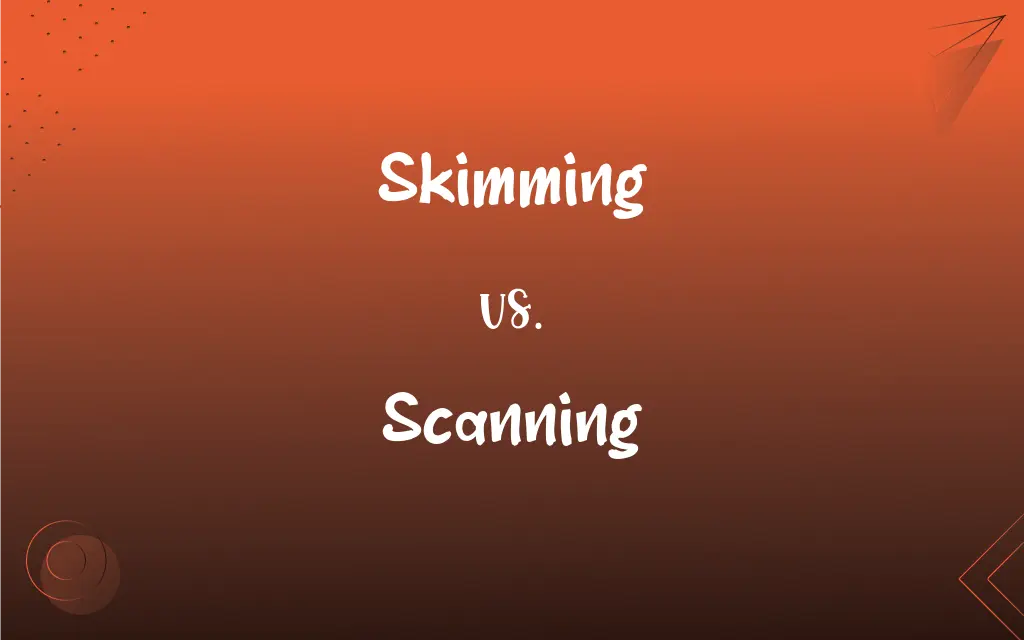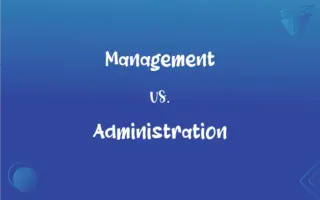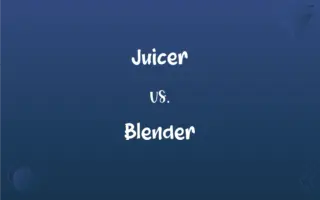Skimming vs. Scanning: What's the Difference?
Edited by Janet White || By Harlon Moss || Updated on October 6, 2023
Skimming is quickly reading to grasp the general idea; scanning is quickly looking for specific information, like keywords or dates.

Key Differences
Skimming typically involves hastily moving through content to garner a general understanding or an overall view of the material, ignoring the finer details. Scanning, conversely, is a reading technique where the reader is in search of specific information, like names, numbers, or facts, and thus doesn’t require understanding of the entire text.
When one skims a text, they might pay attention to headings, subheadings, and words or phrases that are bolded or italicized, as they provide a snapshot of the content's primary themes or ideas. On the other hand, when scanning, a reader might not necessarily pay heed to the thematic guides but will swiftly move through the content, with eyes darting around to locate the specific piece of information or keyword they are looking for.
The motive behind skimming a piece is often to quickly discern whether the text is of interest or relevance without delving deep into its specifics. In contrast, scanning is generally driven by the motive of locating particular information without the need to understand the broader content or context that surrounds it.
Skimming might be likened to taking a bird’s-eye view of a landscape, where one observes the overall terrain, major landmarks, and perhaps the general direction in which one might want to travel. Scanning could be likened to searching that landscape for a particular landmark or feature, like a tower or a river, without concern for understanding the entire topography.
In an educational context, skimming might be employed to quickly review a chapter to decide its relevance to a research topic, absorbing just enough to make that judgement. Alternatively, scanning might be utilized to locate a specific date, name, or fact within that chapter, which has already been deemed relevant to the information being sought.
ADVERTISEMENT
Comparison Chart
Purpose
To grasp a general understanding of the text
To locate specific information within the text
Focus
Headings, subheadings, bold/italicized words
Keywords, numbers, specific facts
Level of Detail
Involves superficial reading
May require slightly focused reading on sections
Time and Speed
Rapid and continuous
Rapid but might pause at instances
Intent & Outcome
Gain a basic idea without detail
Find particular details without overall understanding
ADVERTISEMENT
Skimming and Scanning Definitions
Skimming
Removing a substance from the surface of a liquid.
She was skimming the fat off the soup.
Scanning
Examining closely in search of specific information.
She was scanning the crowd looking for her friend.
Skimming
Moving smoothly along a surface, maintaining contact.
The stone was skimming across the pond.
Scanning
Spreading across a surface methodically.
The spotlight was scanning the audience during the concert.
Skimming
Reading lightly or superficially to understand the general idea.
He was skimming through the book to get its gist.
Scanning
Converting a physical image or text into digital form.
The office assistant is scanning the documents.
Skimming
Stealing a portion from a money transaction.
The cashier was caught skimming from the register.
Scanning
Scrutinizing systematically with a detection device.
The technician was scanning the patient’s body using an MRI machine.
Skimming
Bypassing or omitting sections of text.
Skimming the article, she missed a few key points.
Scanning
Analyzing verse for its rhythmic and metrical pattern.
The poet was scanning the lines to ensure metrical consistency.
Skimming
A portion that has been skimmed from a liquid.
Scanning
To look at carefully or thoroughly, especially in search of something; examine
The sailor scanned the horizon for signs of land.
Skimming
An embezzlement fraud in which the information on a credit card is copied, usually when the owner uses the card to make a purchase, and is then loaded onto a fake card to be used fraudulently.
Scanning
To look over quickly or read hastily
I scanned the newspaper while eating breakfast.
Scanning
(Computers)To search (stored data) automatically for specific data.
FAQs
Which method is faster, skimming or scanning?
Both methods can be quite fast and depend more on the reader’s purpose and proficiency.
Is scanning used to obtain a general understanding of a text?
No, scanning is used to find specific information quickly without reading everything.
Can skimming and scanning be used together?
Yes, one might skim to understand the general content and then scan for specific details.
Do skimming and scanning require in-depth reading?
No, both techniques involve rapid and often non-sequential reading to serve respective purposes.
Can skimming be effective for detailed comprehension?
No, skimming provides a general understanding and overlooks detailed comprehension.
How do skimming and scanning assist in research?
Skimming helps determine the overall relevance of a source, while scanning allows for quick retrieval of specific data or facts.
How can scanning be ineffective in certain reading scenarios?
Scanning might be ineffective when the reader needs a coherent understanding or an overview of a text, as it bypasses context.
Is scanning useful for identifying the main idea of a text?
Not typically; scanning focuses on locating specific details rather than understanding main ideas.
How can I practice skimming effectively?
Focus on reading headings, subheadings, and pay attention to bold or italicized text, and try to grasp the general meaning without reading every word.
Can skimming help determine the writing style of an author?
Partially; skimming may give a broad sense of style but won’t provide insight into the detailed nuances of the author’s writing.
What should I look for while scanning a text?
Focus on finding specific words, numbers, or facts, letting your eyes move quickly until you locate the desired information.
Can I use skimming and scanning techniques for all kinds of reading materials?
Yes, skimming and scanning can be applied to various materials, but they’re particularly useful for informational and non-linear texts.
In what scenario is scanning commonly used?
Scanning is commonly used in scenarios where specific information, like a name or date, needs to be found quickly within a text.
Is scanning practical for appreciating the stylistic nuances of a text?
No, scanning aims to find specific info and generally overlooks nuances and detailed content.
Can skimming provide a comprehensive understanding of a complex topic?
Not usually; skimming offers a surface-level understanding and may miss the complexities and details of a topic.
What is the main purpose of skimming?
To quickly obtain a general understanding of a text without focusing on details.
Are skimming and scanning only applicable to reading text?
Primarily yes, but similar principles might be applied to visually scanning images or skimming videos for general content.
How does skimming benefit fast review of materials?
Skimming allows readers to quickly assess and review the overarching themes or ideas of materials without delving into detailed reading.
When might skimming be most useful?
Skimming is useful when you want to quickly determine the relevance or general content of a text, such as during research or browsing.
Can skimming and scanning be utilized effectively in academic reading?
Yes, they can aid in efficiently sorting through vast amounts of text to identify relevant sources or information.
About Author
Written by
Harlon MossHarlon is a seasoned quality moderator and accomplished content writer for Difference Wiki. An alumnus of the prestigious University of California, he earned his degree in Computer Science. Leveraging his academic background, Harlon brings a meticulous and informed perspective to his work, ensuring content accuracy and excellence.
Edited by
Janet WhiteJanet White has been an esteemed writer and blogger for Difference Wiki. Holding a Master's degree in Science and Medical Journalism from the prestigious Boston University, she has consistently demonstrated her expertise and passion for her field. When she's not immersed in her work, Janet relishes her time exercising, delving into a good book, and cherishing moments with friends and family.































































